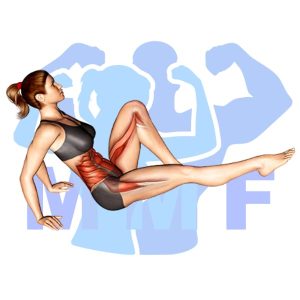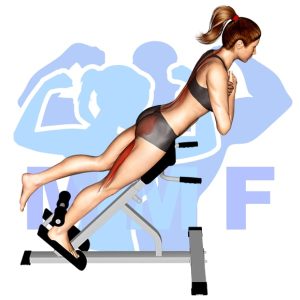Do you struggle with mastering the infamous jack plank? You are not alone! Many fitness enthusiasts struggle with perfecting this move. But fear not, as this is a common problem. Even the most experienced fitness lovers have difficulty nailing the jack plank. However, not being able to perform this move can hinder your fitness journey and limit your capacity. But worry no more! In this blog post, you will learn simple tips and tricks to help improve your jack plank game and take your fitness journey to the next level.
Jack Plank Summary
- Primary Muscles: Rectus Abdominis
- Secondary Muscles: Iliopsoas (Psoas Major & Iliacus), Obliques, Pectoralis major, Quadriceps, Sartorius, Serratus Anterior, and Tensor Fasciae Latae
- Equipment: Body Weight
- Mechanics Type: Isolated
- Force: Pull
- Utility: Auxiliary

Jack Plank Instructions
- Begin by getting in position face down towards the ground in a pushup position.
- Keep your body and your legs straight, then bend your arms, so your elbows are at 90 degrees.
- Now jump your legs apart.
- Then Jump your legs back together.
- Keep jumping your legs back and forth until you are fatigued.
Video Tutorial
Jack Plank Muscles
Target (Agonist)
Synergists
- Iliopsoas (Psoas Major & Iliacus)
- Obliques
- Pectoralis major
- Quadriceps
- Sartorius
- Serratus Anterior
- Tensor Fasciae Latae
Dynamic Stabilizers
- None
Stabilizers
- None
Antagonist Stabilizers
- None

Benefits of Jack Plank
Jack Plank is an excellent exercise for targeting the Rectus Abdominis muscle, which is responsible for flexing the torso forward and sideways. This exercise helps to strengthen the core, as well as the rectus abdominis, allowing for improved posture and a stronger midsection. Additionally, Jack Plank can help to improve abdominal endurance and stability, reducing the risk of injury during other exercises. As a bonus, the exercise also helps to tone and define the abs by increasing their size and strength. Ultimately, Jack Plank is an excellent addition to any strength training or fitness routine that helps to strengthen the core and tone the Rectus Abdominis.
Tips for Performing Jack Plank
If you’re seeking to take the jack plank to a new level, then you’re at the right place. These tips will allow you to benefit fully from this first-class exercise and maximize its effects. Concurrently with shaping your stomach muscles, increasing movability, and also a reduced possibility of injury can all be achieved with this exercise. Let’s get started and take a look at how these suggestions will benefit you.
- Start slow: Take the time to learn the basics of the Jack Plank exercise, and start with a low number of reps so you can get comfortable with the movement. This will help to ensure that you are performing the exercise correctly and avoiding injury.
- Practice good form: Make sure to keep your core engaged and your spine in a neutral position throughout the exercise for maximum effectiveness and safety.
- Increase reps gradually: Aim to increase the number of reps you perform over time as you become more comfortable with the exercise. This will help you build strength and endurance, making it easier for you to reach your fitness goals.
Benefits and Tips Video
Frequent Mistakes To Avoid
When conducting jack plank, avoiding typical errors can be the difference to achieving optimal results and avoiding pain. From improper form to not keeping your core engaged, these mistakes can reduce the productiveness of the exercise and can even raise your risk for injury. Not only can avoiding these mistakes increase your strength, but also can help you feel more assured and motivated when you hit the gym. Let’s start by avoiding these standard errors and add this exercise to your training regimen.
- Not keeping the core tight: People often forget to keep their core engaged during Jack Plank, which can lead to a weak midsection and poor posture.
- Not using the proper form: Incorrect form can lead to injuries and also reduce the effectiveness of the exercise. It’s important to keep your body in line and use correct posture when doing Jack Plank.
- Not going slow enough: Going too fast can lead to sloppy form, which can reduce the effectiveness of the exercise and make it harder to get results. It’s important to go slow and focus on form when doing Jack Plank.
Find More Bodyweight Exercises Here
Variations and Complementary Exercises
If the Jack Plank exercise is not working for you, or you are looking for variations, complementary exercises, or alternatives, there are a few you can try.
Jack Knife

Jack Knife is a great complement or alternative to Jack Plank. It is an exercise that engages both your core and upper body strength at the same time. This exercise is performed by lying flat on your back, feet together and arms extended behind your head. From this position, you curl up and raise your arms and legs towards each other, keeping your core and glutes engaged throughout the motion. Jack Knife is a great way to add variety to your ab routine and works the muscles in a slightly different way than Jack Plank. It can also be performed with a variety of modifications, such as weighted objects or single leg raises, to increase the intensity of the exercise.
Hip Thrust Crunch

Hip Thrust Crunch is a great alternative or complementary exercise to Jack Plank. It involves lying on your back, with your feet flat on the floor and your knees bent. While keeping your core engaged, you lift your hips off the floor and crunch them forward, before lowering them back down to the starting position. The exercise works the core and glutes in a different way than Jack Plank, and can be used as an additional challenge to the original exercise.
Hip Lift

Hip Lift is a great exercise for those looking for an alternative or complementary exercise to Jack Plank. It is an exercise that helps to strengthen the core muscles and also works the glutes, hips and hamstrings. The exercise can be done from a standing or seated position. To do the exercise, start by lying on your back with your knees bent and feet flat on the floor. Then, raise your hips up towards the ceiling, keeping your abs tight and squeezing your glutes at the top. Hold this position for a few seconds before returning to the starting position. This exercise can be made more difficult by adding a resistance band or weight around your legs. Hip Lift is an effective way to strengthen the core, improve balance and stability, and increase muscle tone in the lower body.
Check Out These Top Bodyweight Exercises
Bridge On Knees

Bridge On Knees is an effective exercise that can be used as a complementary or an alternative to Jack Plank. This exercise works the same muscles as Jack Plank and helps to improve core stability. Bridge On Knees is done on a mat, with the person lying on their back and their feet flat on the ground. They then raise their hips off the ground, supporting their weight with their knees, elbows and feet. This exercise strengthens the lower back, glutes and core muscles. It also helps to increase mobility in the hips and spine. Bridge On Knees is a great exercise for those who are looking for an alternative or complementary exercise to Jack Plank.
Bridge

Bridge is a great complementary or alternative exercise to Jack Plank because it works the same muscles in different ways. Bridge requires the participant to lie on their back and lift their hips off the ground while keeping their feet, shoulders, and head in contact with the ground. This exercise strengthens the core, glutes, and hamstrings while also improving balance and stability. Additionally, Bridge is a low-impact exercise that can be modified to fit any fitness level. As such, it is a great option for those looking to switch up their routine or add variety to their workouts.
Bench Crunch

Bench crunch is an excellent complement or alternative exercise to Jack Plank. This exercise helps to develop upper body strength, as well as core stability, by combining a crunch on a bench with a plank. It is performed by lying face up on a bench with the feet planted firmly on the floor and the hands behind the head. The upper body is then lifted off the bench while the core is engaged and held in a plank position for 10-20 seconds before returning to the starting position. Bench crunch is an effective way to target both the upper body and core muscles, making it an ideal exercise for those looking for an alternative or complementary exercise to Jack Plank.
Find More Abs Exercises Here
Opposing Complementary Exercises
By focusing on opposing muscle groups when completing Jack Plank, you can maximize the effectiveness of your workout and reduce the risk of injury. Below are a few exercises that will help you to do so:
Bird Dog Plank

Bird Dog Plank is a great complementary exercise to Jack Plank because it works the opposite muscle groups. Bird Dog Plank requires you to be on all fours, balancing your weight on your hands and knees. From this position, you must raise one arm and the opposite leg out in front of you, and hold that position for 10-15 seconds. This exercise strengthens the core muscles while also engaging the opposing muscle groups of the back, chest, arms, and legs. By doing Bird Dog Plank after Jack Plank, you can ensure that your entire body is receiving a full workout.
45 Degree Twisting Hyperextension

The 45 Degree Twisting Hyperextension is a great exercise to complement the Jack Plank. This exercise works the lower back muscles, which are the opposing muscle group to those used in the Jack Plank. By doing the 45 Degree Twisting Hyperextension, you are working on both stability and strength in the lower back, which will help to prevent any potential injuries that may be caused by the Jack Plank. This exercise will also help to increase balance and coordination, allowing for better performance in the Jack Plank. Ultimately, this exercise will help you to become a better and stronger athlete overall.
45 Degree One Leg Hyperextension

The 45 Degree One Leg Hyperextension is an excellent exercise to complement Jack Plank. This exercise works the hamstrings and glutes while Jack Plank works the core muscles. It can be done using a hyperextension bench or a stability ball. By doing these two exercises together, you are working both the core and the lower body muscles, which helps to strengthen the entire body. This exercise also helps to improve balance and flexibility, making it a great choice for any fitness program.
Planking: The Ultimate Workout to Strengthen Your Core
Planking is a popular exercise that can help strengthen your core muscles, which include the abdominals, obliques, and lower back muscles. By holding a plank position, you engage these muscles to maintain proper alignment and stability. There are different variations of plank exercises, each targeting specific areas of your core, so you can mix and match to fit your fitness level and goals. Whether you’re a beginner or advanced, adding plank exercises to your workout routine can help improve your posture and balance, reduce the risk of injury, and enhance your overall core strength.
References: Wikipedia | ExRx.net | PubMed.gov | Comprehensive List of Abs Bodyweight Exercises

